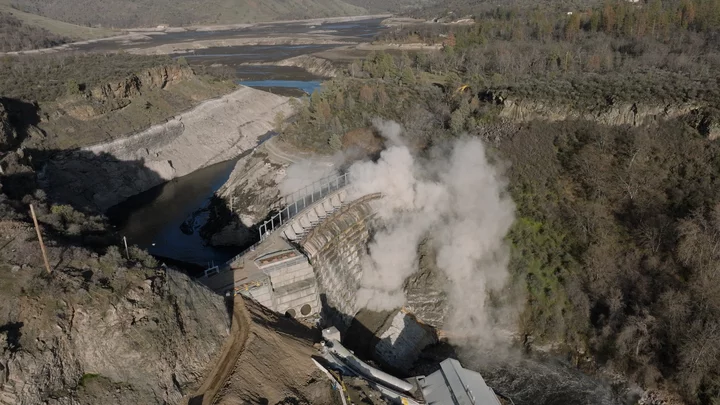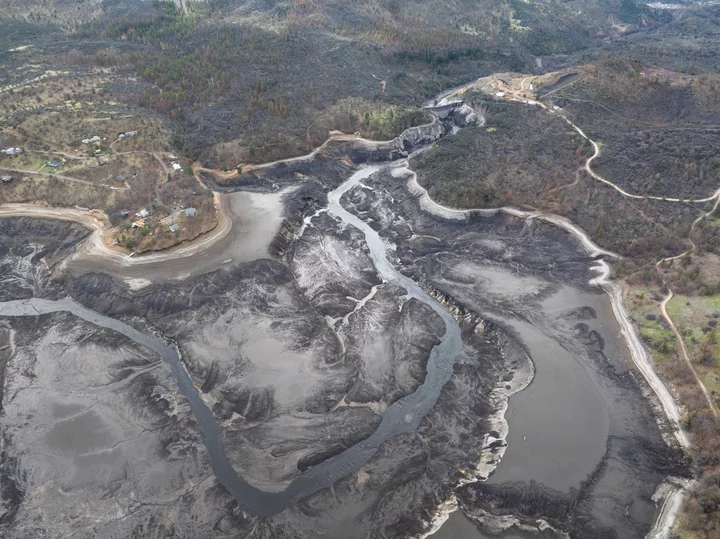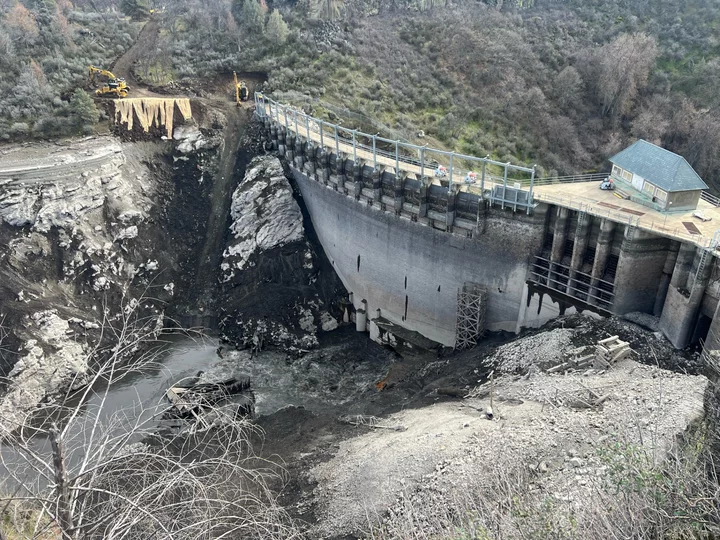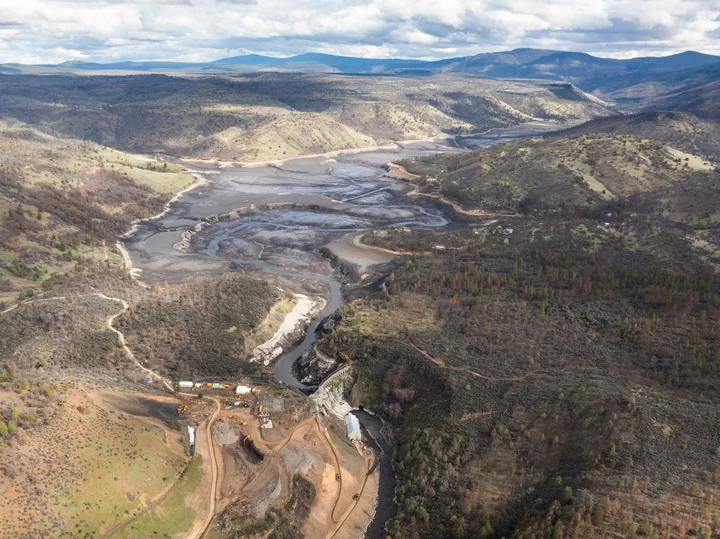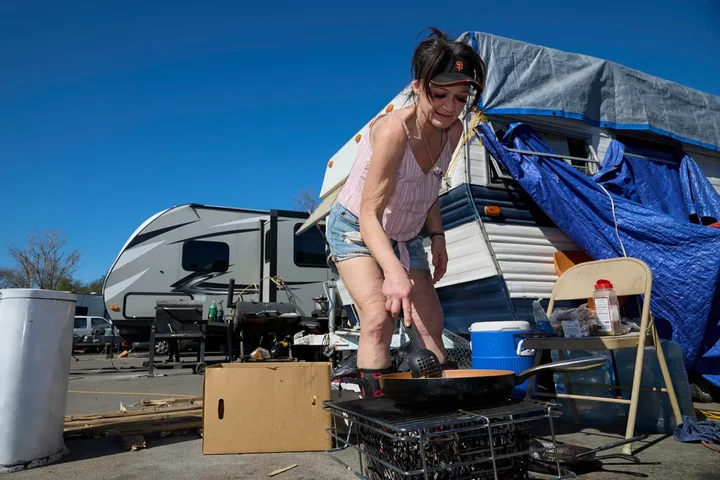Wiyot Tribe Urges Judge to Toss ‘Citizens for a Better Eureka’ Lawsuit Over Removal of Parking Spaces
Ryan Burns / Monday, March 11, 2024 @ 3:05 p.m. / Courts , Local Government , Tribes
The Eureka parking lot at Fifth and D, which is slated to be developed into multi-family housing by Dishgamu Humboldt Community Land Trust, a unit of the Wiyot Tribe. | Photo by Andrew Goff.
###
In court this morning, an attorney representing the Wiyot Tribe urged the judge to dismiss one of several lawsuits filed against the City of Eureka by special interest group Citizens for a Better Eureka (CBE).
The group, which is financed by the Rob Arkley-founded real estate acquisition and management firm Security National, filed five legal complaints last year aimed at halting multi-family housing projects slated for development on under-used municipal parking lots around the city.
Arguing that the loss of parking would be devastating to downtown businesses, the group claims in its lawsuits that Eureka failed to follow the California Environmental Quality Act (CEQA) when it declared the parking lots “surplus property” and invited interested developers to submit proposals for affordable housing projects.
One of the developers to step forward was Dishgamu Humboldt Community Land Trust, a component unit of the Wiyot Tribe, and last July the city awarded development rights to Dishgamu for two projects — one at the corner of Fifth and D streets, very near Security National’s Eureka headquarters, and the other at Sixth and L, next to City Hall.
Today’s case concerned the now-vacant parcel at Fifth and D.
Conceptual design by Dishgamu Humboldt Community Land Trust, a unit of the Wiyot Tribe, for housing at 5th and D streets. | Image via City of Eureka.
###
The Wiyot Tribe was represented in court by Siena Kalina, Indian Law Fellow with the Davis firm of Berkey Williams, LLC. Arguing via Zoom before Judge John Feeney (who was covering for Judge Timothy Canning), Kalina said the Tribe “has a significant interest” in the outcome of the case, even though it was never named as a party in the lawsuit.
“The Tribe has been working very hard to carry out their obligations under the memorandum of understanding [with the City of Eureka] by developing plans and taking steps to acquire funding for the project,” Kalina said. “But this case is directly threatening the Tribe’s work and presenting considerable uncertainty for the tribe and the success of this project.”
She argued that the Wiyot Tribe is “an indispensable party” to the suit, but as a federally recognized Indian Tribe it also has sovereign immunity and thus cannot be “joined” or included in the suit. Therefore, she said, the suit should be dismissed.
She also argued that the Tribe’s plans for the Fifth and D lot are inextricably linked to the outcome of this lawsuit.
“There’s no way this case can be reconfigured to limit the impact to the Wiyot Tribe because the removal of parking that took place at the April 2023 city council meeting is a necessary first step in the Tribe’s development,” Kalina said.
In a rebuttal, Citizens for a Better Eureka attorney Brad Johnson (also appearing via Zoom) argued that the case technically doesn’t involve the Wiyot Tribe at all. It concerns only the legality of the city’s decision to reduce its parking supply by eliminating several lots, a decision that took place months before the city awarded development rights to Dishgamu.
As for the argument that the Wiyot Tribe is an “indispensable party” to the suit, Johnson disagreed, citing as precedent a 1997 case called People ex rel. Lungren v. Community Redevelopment Agency, which he referred to simply as “Lungren.”
That case concerned a southern California tribe’s plans to build a gaming casino in Riverside County via a development agreement with the City of Palm Springs Redevelopment Agency. The California Attorney General filed a complaint, arguing that the deal conflicted with the state’s anti-gambling laws, and the tribe (the Agua Caliente Band of Cahuilla Indians) filed a motion to dismiss on the grounds of tribal immunity.
In that case, Johnson pointed out, the court ultimately denied the tribe’s motion, explaining that “tribal immunity does not extend to barring suit against a third, non-immune party solely because the effect of a judgment against the third party will be felt by the tribe.”
Johnson reiterated that his client, Citizens for a Better Eureka, has no problem with the Wiyot Tribe’s development plans, per se. (Elsewhere, representatives of the group have said that their lawsuits wouldn’t necessarily prevent any downtown housing projects; they’d simply require developers to build even more parking than what’s currently there.)
Johnson said the case is purely about whether the city violated CEQA when it declared the parking lots surplus property in preparation for future housing developments.
“Here,” he said, “the Wiyot Tribe is not party to the action that was challenged. The agreement with the city that they formed months later is not subject to challenge, and there’s nothing in this case, Your Honor, that would undo the agreement between the city and the Tribe. And as counsel for the Wiyot Tribe noted, there may be some delay [in the housing development], but delay is not adequate to trump all of the legal principles outlined in Lungren.”
Johnson asked the court to deny the Tribe’s motion.
In response, Kalina argued that the Lungren case was different than the one at hand and should not be considered as a governing authority.
“This case does affect the Wiyot Tribe,” she said. “The Wiyot Tribe’s development is dependent on the city’s actions at that April meeting to remove parking. … The Wiyot Tribe has exerted significant time and resources to develop this property and would like to be able to continue this development pursuant to their memorandum of understanding and their awarded development rights.”
She added that if the court rules to require additional environmental analysis under CEQA, the Wiyot Tribe will be forced to bear the cost of additional studies before it can proceed with the housing development.
“Your Honor,” Kalina said, “to say that the Tribe has no interest that is affected by this case, and that it’s analogous to Lungren, is just simply incorrect.”
She asked Judge Feeney to grant the dismissal.
The City of Eureka’s attorney, Autumn Luna, appeared via Zoom for today’s hearing but did not address the court. In response to these lawsuits from Citizens for a Better Eureka, Luna argues that Eureka fully complied with CEQA when it updated the Housing Element for its 2040 General Plan. The parking lots slated for redevelopment were designated for affordable housing in that document, which was certified by the state in 2019.
In February, the state’s Attorney General came to Eureka’s defense, urging the court to reject the various legal motions from Citizens for a Better Eureka.
At the outset of today’s hearing, Feeney said he needs more time to read and consider the documents submitted in the case. After today’s arguments he said he’ll take the matter under submission and issue a written ruling before the end of this week.
###
PREVIOUSLY:
- The Eureka City Council Wants Developers to Build Affordable Housing on Three City-Owned Parking Lots
- Eureka Planning Commission Chair Jeff Ragan Abruptly Resigns, Citing ‘Grave Concerns’ Over City’s Approval of Housing Projects on Three City-Owned Parking Lots
- The City of Eureka is Gearing Up to Turn Three More Parking Lots into Affordable Housing Developments, Including the Two Lots at City Hall
- Arkley Threatens Lawsuits, Referendum, Recall Drive Over City of Eureka’s Plans to Convert Parking Lots to Housing
- Eureka City Council Postpones Vote on Proposed Parking Lot Land Swap
- ‘Furious’ Rob Arkley Says He’s Moving Security National HQ Out of Eureka After Clashing With City Staff About Development Priorities
- New Group — ‘Citizens for a Better Eureka’ — Says It Will Sue Eureka Over Downtown Housing Development
- Here is the Housing Development/Parking Lot Lawsuit Served on the City of Eureka Today
- Arkley-Affiliated Group ‘Citizens for a Better Eureka’ Files Second Lawsuit Against the City Over Development Plans
- Local Group Announces Intent to Stop the City of Eureka’s Conversion of Downtown Parking Lots Into Housing With New Ballot Measure
- Wiyot Tribe Makes Its Case, Convinces Eureka Council to Reject Staff Pick and Award Affordable Housing Development Projects to Tribal Land Trust Agency
- Group Circulating Eureka Housing Petition Says the Wiyot Tribe’s Projects Are OK, Clarifies That Parking Lot Conversions Will Be Allowed So Long as Developers Build Even More Parking Than Before
- Eureka Gets $30 Million Grant for Housing Projects That the ‘Housing For All’ Initiative Hopes to Block
- New Coalition — ‘I Like Eureka Housing!’ — Formed to Oppose Arkley-Backed Pro-Parking Lot Initiative
- (UPDATE) Arkley-Affiliated ‘Citizens for a Better Eureka’ Files Two More Lawsuits Against the City, Aiming to Block Linc Housing Developments
- State Attorney General’s Office Joins the Fight Against the Pro-Parking Group ‘Citizens for a Better Eureka’
BOOKED
Today: 2 felonies, 11 misdemeanors, 0 infractions
JUDGED
Humboldt County Superior Court Calendar: Today
CHP REPORTS
862 Mad River Rd (HM office): Trfc Collision-Unkn Inj
2356 Mm299 E Hum R23.60 (HM office): Trfc Collision-Unkn Inj
13636 Mm101 N Hum R136.40 (HM office): Trfc Collision-1141 Enrt
7730 Mm101 S Men 77.30 (HM office): Trfc Collision-No Inj
ELSEWHERE
Governor’s Office: Governor Newsom issues legislative update 10.13.25
RHBB: Controlled Burn Planned Near Laytonville as Part of Forest Health Initiative
RHBB: Firefighters Respond to the Report of a Fire in Redcrest
HipHopHumboldt: Episode 67 - Kai Sway
‘Simply Catastrophic’: California Salmon Season to Be Restricted or Shut Down — Again
Rachel Becker / Monday, March 11, 2024 @ 1:34 p.m. / Sacramento
Chinook Salmon swimming along the Scott River on Oct. 30, 2023. Photo by Larry Valenzuela, CalMatters/CatchLight Local
California’s fishing industry is bracing for another bad year as federal managers today announced plans to heavily restrict or prohibit salmon fishing this year, following a complete ban last year.
The Pacific Fishery Management Council today released a series of options that are under consideration, all of which either ban commercial and recreational salmon fishing in the ocean off California or shorten the season and set strict catch limits. The council’s final decision is expected next month; the commercial season typically begins in May and ends in October.
While more Chinook salmon returned from the ocean to spawn last year than in 2022, fishery managers said the population is expected to be so small that they must be protected to avoid overfishing.
Fall-run Chinook salmon are a mainstay of commercial and recreational fishing and tribal food supplies. But their populations are now a fraction of what they once were — dams have blocked vital habitat, while droughts and water diversions have driven down flows and increased temperatures, killing large numbers of salmon eggs and young fish.
The plan is a devastating blow for an industry still reeling from last year’s closure. State officials estimate that last year’s closure cost about $45 million — which the fishing industry says vastly underestimates the true toll.
“There’s no way to sugarcoat it, as it’s simply catastrophic,” said Scott Artis, executive director of the Golden State Salmon Association, which represents the commercial and recreational fishing industry, other businesses, restaurants and environmentalists.
“The fishing industry and many thousands of salmon families and businesses eagerly waiting to get back to work are potentially facing another year in the harbor instead of putting food on the table.”
The options are likely to evolve as the Pacific Fishery Management Council continues to analyze them over the next month. Two call for significantly shortened seasons and harvest limits for both commercial and sport fishing off California this year. The third would cancel the season for the second year in a row.
“In response to poor river and ocean conditions, California stocks are forecast to have 2024 abundance levels that are well below average,” Marci Yaremko, the California Department of Fish and Wildlife’s appointee to the Pacific council, said today. “The options that have been developed that do authorize some fishing are very precautionary.”
Harvest limits and other restrictions on the number of fish caught per trip are new concepts for managing ocean salmon fisheries, Yaremko said.

Jared Davis stands aboard his boat, the Salty Lady, in Richmond on March 8, 2023. Photo by Martin do Nascimento, CalMatters
“Even the best option that they give us there is crumbs compared to a regular salmon season,” said Jared Davis, captain of the Salty Lady, a charter fishing boat.
Still, of all the options, he said, he’d prefer complete closure. The shortened seasons don’t offer enough days to sustain his business and the potential repercussions aren’t worth it.
“I think fishing on low abundance such as we have this year is reckless and irresponsible,” he said. “It’s really playing with fire for us to take any fish out of there.”
Sarah Bates, who owns a commercial fishing boat berthed at Fisherman’s Wharf in San Francisco, called the decision “tragic.”
“We’re looking at numbers of fish that don’t even make it worthwhile to untie the boat,” she said. “It’s not enough fish to pay for the maintenance and preparation.”
A financial nightmare — some may never fish again
RJ Waldron, 48, put his sportsfishing boat, the Sundance, up for sale in January. When the salmon season closed last year, an estimated 85% of his business dried up. Few clients took him up on his offer to switch to halibut, striped bass or rockfish.
Buying the boat eight years ago to run a charter fishing business out of the East Bay had been a dream come true for Waldron, a long-time fishing and hunting guide.
“Basically this last year, I’ve just been blowing through my cash, blowing through the savings, just trying to stay afloat,” Waldron said. “I put everything I had into this fishing business, into the salmon. And it’s totally out of my control. I can’t resurrect it.”
“We’re looking at numbers of fish that don’t even make it worthwhile to untie the boat. It’s not enough fish to pay for the maintenance and preparation.”
— Sarah Bates, commercial fisherwoman in San Francisco
California’s commercial fleet and recreational anglers still await federal disaster aid for last year’s losses. The federal government allocated only $20.6 million in disaster funding, and a year later, none of the salmon fishers CalMatters interviewed has received a check.
Waldron called the lack of disaster aid a “big slap in the face.”
Davis said he tried to weather the storm by arranging trips for halibut, striped bass, rockfish and lingcod. Still, he estimates that his business was down 80% from a normal year.
Seeing the season restricted this year, “breaks my heart,” he said. “It’s what I love, and it’s a passion. It’s something I’ve been doing my whole life, and I know that there’s a lot of others in the industry that it’s the same for.”

Fishing boats at a dry dock in Richmond on March 8, 2023. Photo by Martin do Nascimento, CalMatters
Salmon fishers fear the closure will drive yet more boats permanently from the fleet — already down to 464 vessels in 2022 from nearly 5,000 in the early ‘80s. Recreational salmon fishing trips plummeted from nearly 99,000 in 2022 to zero.
Bates estimates that about half the fleet picked up shore jobs. And some, she said, probably won’t return.
“Some people, I’m sure, will not go fishing again,” she said. “They got a job that will hold them through and their momentum will shift, and I’m sure we’re going to lose members of our fleet.”
To make ends meet last year, Bates picked up bookkeeping work. But she doesn’t know yet what she’ll do this year. Bates’ boat is called the Bounty, a cruel irony the past year. Still, she said the boat has seen bad seasons before — and it’s bad luck to change a boat’s name, she said.
Tommy “TF” Graham also will keep working on land. A commercial fisherman based in Bodega Bay, he got a Class A driver’s license so he could drive a truck and stay afloat through the closures. Now, when he’s not crab fishing, Graham wakes up at 3 a.m. to drive frozen and farmed salmon and other fish from around the world into San Francisco.
“A guy has got to get up and put his boots on and go to work every day,” Graham said. Still, he said, “I used to be a provider, now I’m a consumer. It feels like shit, to tell you the truth.”
Tribes with subsistence fishing do not have to follow the federal recommendations, although they often cancel or heavily restrict their own seasons.
‘Disastrous’ salmon numbers
Today’s decision follows the release of population numbers that industry experts called disastrous.
Sacramento River fall-run Chinook make up the greatest proportion of the California and Oregon ocean salmon fisheries. Their numbers are down from an average of more than 200,000 fish that returned to spawn in the mid-2000s. And those numbers are a fraction of the historical counts of between one and two million fall and spring-run salmon returning to the Central Valley every year.

Last year, fewer than 134,000 returned to the Sacramento River. That’s more than double the fish that returned in 2022, which was the third lowest count on record. But it barely cleared the federal government’s minimum conservation target of 122,000 fish, and falls 19% short of the number that had been projected to return — despite the cancellation of all salmon fishing.
Now, scientists estimate that 213,606 Sacramento River fall-run salmon are swimming off the coast. It’s more than last year — more even than the upper limit of the fishery’s conservation target. But it is still the second lowest projection in a decade, according to a guidance letter from the National Marine Fisheries Service. “Caution is warranted to reduce the chances that the stock becomes overfished again.”
Federal officials attributed the struggling populations in part to low flows and high temperatures on the Sacramento River during California’s drought in 2021, when the fish returning this year were spawned.
But the salmon industry also points to state and federal management of the Sacramento River and operations of the vast Central Valley Project, which funnels water south from Northern California’s rivers to irrigate a third of the state’s agricultural land and supply a million households.
In 2021, almost all of the endangered winter-run Chinook eggs in the Sacramento River were wiped out, cooked in dangerously hot water. The Pacific Fishery Management Council told state and federal water managers in 2022 that the conditions also could harm eggs of spring-run and fall-run Chinook salmon. Expressing their “grave concerns,” they said “a major factor” was the “high river temperatures that were under (the U.S. Bureau of) Reclamation’s control.”
The Newsom administration has come under fire from conservationists and the fishing industry for actions that could jeopardize salmon, including waiving water quality requirements in the Delta and backing a controversial pact with major water suppliers related to diversions from the Bay-Delta watershed.
“It’s really hard for me to swallow that we export all this water and have little to no regulation on the farming,” Waldron said. “We’re taking away from a resource to give to another resource. And I don’t understand how we can let that happen, especially (since) the salmon are a natural resource.”
The Newsom administration unveiled a plan in January aimed at protecting and restoring salmon “amidst hotter and drier weather exacerbated by climate change.”
###
CalMatters.org is a nonprofit, nonpartisan media venture explaining California policies and politics.
CHAMPS! St. Bernard’s Academy Girls’ Basketball Team Dominates in Sacramento to Claim State Crown
LoCO Staff / Monday, March 11, 2024 @ noon / LoCO Sports!
Holy wow! Three or more cheers are in order for St. Bernard’s girls basketball team who made history over the weekend by becoming the first team in H-DNL history to earn a state championship.
Taking the court at the Sacramento Kings’ Golden 1 Center on Saturday morning, the team scored a dominant 47-29 win over Grossmont High School out of San Diego.
Take that, SoCal! Read more at the Humboldt Sports.
(PHOTOS) Deconstruction Underway on Copco No. 1, the Second of Four Dams Slated for Removal on Klamath River
LoCO Staff / Monday, March 11, 2024 @ 10:03 a.m. / Environment , Infrastructure
Copco No. 1 goes boom. | Image by Swiftwater Films, courtesy KRRC.
###
Press release from the Klamath River Renewal Corporation:
Hornbrook, CA – Following Friday’s successful test blast, the Klamath River Renewal Corporation will proceed with the removal of the Copco No. 1 Dam, the second dam to be removed as a part of the Klamath dam removal project.
The Copco No. 1 Dam, constructed in 1918 for the sole purpose of hydroelectric power generation, has blocked fish passage for over 100 years and is expected to be fully removed by the end of August 2024.
“We are excited to get to work,” said Mark Bransom, CEO of the Renewal Corporation “with the initial phase of drawdown complete, the dam is fully exposed and can safely be disassembled.”
Copco No. 2, a diversion dam that was located just downstream of Copco No. 1, was removed last year. The remaining three dams, Copco No. 1, Iron Gate, and JC Boyle, created reservoirs that needed to be drawn down before removal could begin. The initial phase of drawdown concluded last month, and shortly thereafter FERC approved an advancement in the schedule, allowing for the removal of Copco No. 1 ahead of the other remaining dams.
Iron Gate and JC Boyle, which are clay core earthen dams, will remain at their full height until the spring runoff period has concluded and the Klamath River has returned to baseline flows. Work on their deconstruction will likely begin sometime in May, depending on precipitation.
Deconstruction of the Copco No.1 Dam, which will be performed through a repetitive cycle of drilling, blasting, and chipping, can begin before the spring runoff period has concluded because it is a concrete arch dam. So, should the Klamath River experience a significant flow event this spring, water could safely pass over the partially removed concrete dam and the dam would remain securely in place. The Copco No. 1 Dam removal plan was specifically designed to allow for this safe flow passing, should it occur.
The removal of Copco No. 1, Iron Gate, and JC Boyle Dams is expected to be complete sometime this fall, in time for the Fall run of Chinook salmon. The restoration of the former reservoir footprints is currently underway and will continue for several years until vegetation is successfully established and water clarity has returned to baseline conditions.
Photo by Shane Anderson.
The drawn-down reservoir behind Copco No. 1. Restoration is currently underway. | Photo: Swiftwater Films.
Backside of the Copco No. 1 dam after drawdown. | Photo: Swiftwater Films
Drawn-down reservoir looking upstream from Copco No. 1. | Photo: Swiftwater Films.
Photo: Swiftwater Films.
These Gigs Offer Paths to Higher Wages for Young Californians. Now They’re Facing Budget Cuts
Alejandra Reyes-Velarde / Monday, March 11, 2024 @ 7:58 a.m. / Sacramento
High school senior Catalina Govea, 17, helps a fourth-grade student at Linden Elementary School in San Joaquin County as part of a youth apprenticeship program on March 5, 2024. Photo by Manuel Orbegozo for CalMatters
California is just starting a statewide effort to create apprenticeship opportunities for young people, ages 16 through 24, as college becomes less affordable for many high school graduates and other costs of living are rising.
But the program has run into a funding snag. Gov. Gavin Newsom, trying to plug a budget hole that some officials say could be $78 billion, now plans to delay $25 million in next year’s funding — about how much the state is spending this year on the effort.
This could be a setback for a new system that funds apprenticeships strictly for young people. Currently most apprentices are older than college age — the nationwide average age of an apprentice is 29 — and most apprenticeship programs feed into the construction trades.
State officials think much younger people should be tapping into this system.
“Not everybody can afford to go onto college, but that doesn’t mean that they’re not bright, hard working people,” said Adele Burnes, deputy chief of the state’s Division of Apprenticeship Standards. “It just means they may not be able to afford to not be earning.
“We as a state want to make sure we’re creating onramps into careers … that offer them that pathway into a family-sustaining wage.”
Those who complete apprenticeships can earn starting salaries of $77,000, and their average lifetime earnings could outpace their peers’ by more than $300,000, according to research by Jobs for the Future, a national organization that promotes workforce development.
Last July the Legislature tasked the Division of Apprenticeship Standards with gathering data and developing a system for allocating money to groups that operate youth apprenticeship programs.
Organizations have until March 15 to apply for funding.
Defining youth apprenticeship
The Division of Apprenticeship Standards has established grants for organizations that develop pre-apprenticeship and apprenticeship programs targeting the state’s 500,000 “opportunity youth” — young people who have dropped out or are at risk of dropping out of school, or who come from low-income families or neighborhoods, or are involved in the foster care, child welfare or juvenile justice systems.
The organizations that receive the grants are expected to develop apprenticeship programs for careers in health care, education, information technology and more.
The effort is in line with Newsom’s stated goal of reaching 500,000 registered apprentices by 2029. So far, the state has about 90,000.
Typically apprenticeship programs are federally registered and involve at least 144 hours of classroom instruction and 2,000 hours of on-the-job work under the supervision of a professional.
“Legislatively there needs to be some sort of an incentive, some sort of a tax credit, anything for employers to invest in the youth.”
— Pam Knapp, director of college and career readiness, San Joaquin County Office of Education
Those who complete apprenticeships usually secure union jobs with living wages and benefits, said Taylor White, who helps design youth apprenticeship systems for New America, a national research and advocacy nonprofit.
Historically apprenticeships mostly fed the building and fire trades. Many union jobs require employees to be over 18, White said.
The national decades-long “college for all” push in high schools has steered young people by the droves toward four-year colleges. But college hasn’t worked out equally for everyone.
“That hasn’t necessarily resulted in the closure of the workforce and economic disparities that people expected it would,” White said. It’s now clear that young people need more options, she added.

While various pre-apprenticeship programs in the state prepare young people for apprenticeships, California has yet to create a central youth apprenticeship system to recruit workers who may still be in high school or college.
The state established a Youth Apprenticeship Committee that is expected to provide recommendations to the Division of Apprenticeship Standards in July.
California high school apprenticeships
One example of a new high school apprenticeship program is San Joaquin County’s Apprenticeships Reaching Career Horizons, the first of its kind in the state.
Three of the six young people who started at its beginning in 2020 have since completed the three-year program. To date there have been 25 students in the program, said Pam Knapp, director of college and career readiness at the San Joaquin County Office of Education. Students can train as teaching aids, assistant farm managers or hospitality marketing professionals.
When Catalina Govea, a Linden High senior, applied to the program, she thought she was applying for a summer job. It turned out to be a lot more, she said.
“Once I got the position, I immediately fell in love because I knew I wanted to be a teacher,” Govea said.

High school senior Catalina Govea, 17, part of a youth apprenticeship program, says it has given her management skills and patience she will use in her future career in education. Photo by Manuel Orbegozo for CalMatters
Govea works in Linden Elementary classrooms and in afterschool programs as a teacher’s aide, assisting teachers with administrative work and students with assignments and learning about classroom management.
She also takes online college courses on childhood and adolescent development, child discipline and other education topics that will transfer when she starts at Sonoma State University in the fall.
The program, Govea said, has helped her mature and handle stressful classroom environments, experience she might not have otherwise gained until years later.
The experience was “perfect to know what my future would look like,” she said.
Knapp said the apprenticeship program works well because the county Office of Education functions as an intermediary between employers, school districts, and the state Division of Apprenticeship Standards.
But the program has faced challenges convincing enough employers to hire teenagers, she added.


Catalina Govea works with students and faculty during school hours and after school as part of a high school apprenticeship program that combines technical instruction with paid work experience on March 5, 2024. Photos by Manuel Orbegozo for CalMatters.
There are higher workers compensation rates for workers under 18, so private companies may be hesitant to hire them, Knapp said. And unions representing school workers are hesitant to hire teenagers if those jobs could instead go to union employees, she added.
“That’s been the heavy lift,” Knapp said. “If we want to expand this, then legislatively there needs to be some sort of an incentive, some sort of a tax credit, anything for employers to invest in the youth.”
In the Bay Area, the Construction Trades Workforce Initiative is running its pre-apprenticeship programs as a pipeline for high school students interested in such fields as construction and plumbing.
Beli Achary, the initiative’s executive director, said the program has done a lot of outreach work to educate school counselors and employers about the importance of opening up apprenticeships to youth. The initiative also visits high schools in the Bay Area to inform students about the careers they can explore through apprenticeship programs.
The initiative oversees, funds and authorizes several pre-apprenticeship programs with school districts and juvenile detention centers across the Bay Area. They are in the process of developing programs for at least five more school districts and Laney Community College in Oakland.
“The attitude has shifted and is a lot more positive,” Achary said. “Workforce development is becoming more and more of a buzzword, which is a good thing.”
Ensuring equitable outcomes
Traditional apprenticeships, mostly in the building and fire trades, have skewed white and male.
Across the country, 63% of youth apprenticeships have gone to people who identify as white and 35% to those identifying as nonwhite, according to the Jobs For the Future report, which analyzed data for 2010 through 2020.
Women and girls make up 7% of all youth apprentices nationally.
After an apprenticeship, the average starting wage for youth apprentices was $31 an hour, the study said: white youth earned $29.55, Latino youth earned $32 and Black youth earned $23, it said.
While young men’s pay averaged $13.08 an hour, males who had apprenticeships earned $31 an hour, a 137% boost. For young women, those with apprenticeships earned 42% more than the average, the study said.
The report says occupational segregation is key to starting wage disparities, highlighting the need to recruit to diversify various occupations.
For example, the top occupation for women apprentices was pharmacy technician, which nationally paid $12 an hour. The top occupation for male apprentices was electrician, which paid $26 an hour, according to the report.
“We as a state want to make sure we’re creating onramps into careers.”
— Adele Burnes, deputy chief of state’s Division of Apprenticeship Standards
“Providing more information and awareness, I think, will be a key part of working through some of those inequities,” said Myriam Sullivan, a researcher on the report. That includes educating employers on how to keep diversity in mind when hiring and informing young people about wages in various career paths.
Sullivan said some of the lack of diversity in apprenticeships may have to do with how they’re funded. Because grants typically incentivize high enrollment, that leaves little room for program leaders to think strategically about hiring diversely, she said.
California’s apprenticeship grant language targets groups that serve youth who are typically shut out of these opportunities, said Burnes, of the state apprenticeship standards division. The state program also tries to ensure organizations can support youth through the completion of their programs.
“What we heard resoundingly was just how important supportive services are to opportunity youth who are trying to get into apprenticeships,” Burnes said. They “face unique life challenges and barriers that might make their success in a program a step harder.”
Eric Morrison-Smith, executive director of the Alliance for Boys and Men of Color, a national youth advocacy network which co-sponsored California’s youth apprenticeship legislation, said the priority must be ensuring young workers have more options than they’ve had in the past and building worker power.
“I think the pendulum is shifting a bit,” he said. “Historically the pendulum has leaned heavily on the side of ‘college is the only way to get a good job.’ We believe we need a solid ecosystem of economic opportunity that allows for people to make decisions that will give them more self determination over their lives.”
Morrison-Smith said supporters of the Youth Apprenticeship program are lobbying Senate and Assembly leaders to ensure it remains a priority in budget negotiations.
###
CalMatters.org is a nonprofit, nonpartisan media venture explaining California policies and politics.
Sacramento Gave a Homeless Camp a Lease as an Experiment. Here’s What Happened
Marisa Kendall / Monday, March 11, 2024 @ 7:51 a.m. / Sacramento
Jeanne Gillis cooks ground turkey over a wood fire beside her trailer at Camp Resolution on Feb. 28, 2024. Residents must rely on bottled water, generators, and wood fires because no utilities are provided at the camp. Photo by Fred Greaves for CalMatters
When Sacramento changed its plan to demolish a homeless encampment on a vacant lot on Colfax Street, instead offering the homeless occupants a lease, activists and camp residents celebrated it as a win.
The first-of-its-kind deal, which allows the camp to remain in place and govern itself without city interference, was held up as a model Sacramento could replicate at future sites. Other cities, including San Jose, have said they’re considering similar models, putting the success or failure of this encampment under the microscope.
A year later, Sacramento has not managed to reproduce the concept and has no plans to. Residents of the camp, who lack electricity or running water, complain they feel forgotten. And the county district attorney, claiming the site threatens public safety, has demanded the city clear the camp or risk prosecution.
Those troubles highlight the logistical and ethical dilemmas that come with setting aside outdoor spaces for homeless residents to go when there aren’t enough beds indoors. And it comes at a time when officials across the state increasingly are turning to this last-ditch solution as they face mounting pressure to clear encampments away from sidewalks, parks, schools and other high-traffic public areas.
“The fact that people have a place where they can legally exist and not be threatened with arrest, not be run off and have to lose their belongings, where they can go to the bathroom with dignity, where there’s trash pickup so they don’t have to live in a place where there’s trash all over, where service providers can find them regularly and they aren’t going to lose contact with people as they work their way to housing — those are all good things,” said Eric Tars, senior policy director of the National Homelessness Law Center. “But it would be even better if they were doing them indoors.”
They got a lease, and they make their own rules
Camp Resolution, as the Sacramento camp is known, was started in 2022 by Sharon and Joyce Jones — a married couple in their 50s who found themselves homeless for the first time late in life. More than four-dozen people now live there, some in new-looking Bullet trailers provided by the city, and others in cars, tents and more dilapidated trailers and RVs.

Joyce and Sharon Jones poke holes in a water bottle to water their garden next to their trailer at Camp Resolution on Feb. 28, 2024. The camp has no running water, so residents must rely on bottled water for all their needs. Photo by Fred Greaves for CalMatters
Some residents have taken pains to make it more homey: Two potted plants hang from the hitch of one trailer, chickens roam the lot, and Sharon and Joyce are putting in a garden, using pallets to make raised planter beds.
“We try to make it as comfortable as possible,” Joyce said, “but sometimes it’s impossible.”
Shortly after Joyce and her community occupied the city-owned, formerly vacant lot in 2022, city workers determined the camp was unsafe and needed to be demolished — as often happens in Sacramento and throughout California. But that’s where the story takes an unusual turn. Residents of the camp, and their supporters, showed up in force to a city council meeting and persuaded council members to delay the sweep. About six months later, the city signed a lease allowing the camp to remain in place.
The lease, which advocacy group Safe Ground Sacramento signed on behalf of the Camp Resolution residents, was an experiment. Generally, similar programs are run by nonprofits contracted by a city. They often impose curfews, no-guest policies, sobriety requirements and other rules on residents. In exchange, they offer social services such as counseling or help finding permanent housing, and amenities such as showers and bathrooms.
“They don’t think people experiencing homelessness are capable of governing themselves,” Tars said.
Camp Resolution is different. Safe Ground Sacramento, which leases the property from the city for free, takes a hands-off approach that lets residents run the camp and write their own rules. The city gave the residents a handful of residential trailers, set up portable toilets and a hand-washing station, and provided dumpsters and ongoing trash pickup. But that’s it.
Many activist groups laud that model as a best practice, saying it’s important to let the residents run, or at least help run, their own camp.
“When individuals in these encampments have a sense of ownership, then it can really lead to the camp being a place that they take pride in and that they are trying to keep in as good condition as possible,” Tars said. “It gives a sense of responsibility to others in that community.”
It also means minimal overhead for the city: The trailers provided to Camp Resolution residents came from the Federal Emergency Management Agency at no cost to the city of Sacramento, and adding the camp to the city’s existing contract for trash pickup didn’t add any additional expense.
But in the case of Camp Resolution, it also means residents are left to fend for themselves. The city doesn’t provide electricity or running water. Community members donate food, some residents have generators, and a nonprofit used to bring a trailer with showers every other Sunday — but they recently stopped.
“It’s not going very well,” Joyce said. “I think that (the city) should do a little bit more.”

Jeanne Gillis uses tubs to wash dishes next to her trailer at Camp Resolution on Feb 28, 2024. Photo by Fred Greaves for CalMatters
The Camp Resolution lease says the city would provide up to 33 trailers. Residents ended up receiving just 16. But 51 people live at the camp, meaning some people sleep in tents, in their cars or in dilapidated trailers and RVs that leak in the rain and have sprouted mold.
The city wouldn’t comment on the trailers — or anything else — citing a pending threat of prosecution from the county District Attorney’s Office. City officials recently sent 40 trailers to a new safe sleeping site they opened on Roseville Road, which also has plumbed toilets and showers.
Several of the Camp Resolution residents are elderly, and some have serious medical issues that make living without reliable power and water difficult. One woman, who recently turned 60, is on dialysis and gets around on an electric mobility scooter that she leaves parked outside her trailer.
Most of the residents are women, some of whom wouldn’t feel safe on the streets by themselves. Jeanne Gillis, 53, was cooking ground turkey over an open flame outside her trailer on a recent Wednesday. Gillis, who used to work as a medical patients’ advocate, lost her housing two years ago when she got sick with lupus and could no longer work. She’d never been homeless before and didn’t know what to do — so Sharon and Joyce took her under their wing. Now she’s part of their tight-knit community.

Jeanne Gillis cooks ground turkey over a wood fire next to her trailer at Camp Resolution on Feb. 28, 2024. Residents must rely on bottled water, generators, and wood fires because no utilities are provided at the camp. Photo by Fred Greaves for CalMatters
“Thank God for everybody. Because it’s hard,” she said, tearing up. “I don’t think I’d be here if it wasn’t for everybody.”
Camp Resolution faces legal threat
Camp Resolution also faces an outside threat — Sacramento County District Attorney Thien Ho has demanded that the city close the camp. His office sent a letter to the city and Safe Ground Sacramento in November labeling the site a public health hazard. The site is contaminated by toxic chemicals left over from when it was used as a vehicle maintenance yard and held underground storage tanks for diesel and gasoline, he said. It’s not safe to camp on the contaminated soil, according to his letter. But only half of the site is paved, while the other half is bare dirt — and people live on both sides.
Ho’s office did not set a specific deadline for the city to clear the encampment, leaving it unclear exactly what, if anything, will come of his threat.
When asked about Ho’s next steps, Sonia Martinez Satchell, a spokesperson for the District Attorney’s Office, indicated prosecution is still on the table.
“To date, the City has failed to move the unhoused off this toxic waste site,” she said in an emailed statement. “We will not waiver from our commitment to protect public safety for all. As outlined in our letter, all available actions and recourse remain available.”
But camp residents and the advocates working with them say they’ve heard nothing but silence from the District Attorney’s Office since the November letter. That means the fate of those living at Camp Resolution is still up in the air.
Tim Swanson, spokesman for the City Manager’s Office, said the city can’t comment on any aspect of Camp Resolution because of the pending threat of prosecution.
Sharon and Joyce aren’t concerned — they claim the camp isn’t on the portion of the site that’s contaminated. Ho’s letter is just an excuse to try to kick them off the property, they said.
Sanctioned homeless encampments in California
Faced with a massive shortage of affordable homes, desperate city officials across California are considering opening places where unhoused people can legally set up tents. The move could give them more power to clear encampments from around parks, schools, downtown zones and other high-profile areas. That’s because unless cities have somewhere for displaced unhoused residents to go, the 2018 appellate case Martin v. Boise limits the extent to which they can clear encampments. That could change soon, as the Supreme Court has agreed to take up the case and will hear arguments next month. But for now, cities’ hands remain largely tied if they lack enough shelter beds.
San Diego recently passed an ordinance banning encampments in much of the city. As the city ramped up enforcement, it opened two sanctioned camp sites that together can hold more than 500 tents.
After the city rejected the idea three years ago, San Jose Mayor Matt Mahan recently said he’s considering opening similar sites.
Safe sleeping sites take many different forms — and have a range of price tags. In August, after the city stalled in its attempts to open safe sleeping sites, Sacramento City Manager Howard Chan single-handedly tried to identify locations for the projects. He initially said Camp Resolution could be a model for future sites — because it cost the city so little to run, it would allow the city to open more sites than if they used more expensive models.
Instead, the city in January launched its next safe sleeping site, on Roseville Road, with more services, more oversight and a greater cost — $3.2 million per year. The site has 60 rudimentary tiny homes and 40 trailers, and is governed by a nonprofit contracted through the city.
But, due to an anticipated budget shortfall for the coming fiscal year, the city has no plans to launch additional safe sleeping sites, Swanson said. At a committee meeting last month, city staff predicted that by next year, the city’s budget for homeless services would be short $11 million. By the 2025-26 fiscal year, they expected to be short nearly $39 million.
Life at Camp Resolution
There are about 800 people on the waitlist to get into Camp Resolution, according to Sharon and Joyce. Only six people from the camp have moved out and into permanent housing, they said. Just on the other side of the gate that separates Camp Resolution from the rest of the world, a group of people live in a cluster of cars parked haphazardly on the side of the road. Across the street, someone has erected a makeshift shack. RVs that serve as stand-in homes line the road.
Inside the gate, Sharon and Joyce tend to have the ultimate say in what goes, though there’s also a council that meets on Thursday evenings to discuss camp issues. Things don’t always go smoothly.

Camp Resolution, a “self-governed” homeless camp on city-owned land in Sacramento, on Feb. 28, 2024. Photo by Fred Greaves for CalMatters
Last year a neighbor’s dogs attacked Sharon and sent her to the hospital with multiple bite injuries. That led to new rules at the camp about pets. But Sharon and Joyce say it’s hard to actually enforce the rules they impose.
“We need more structure,” Sharon said.
As they showed off the different parts of their community, Sharon and Joyce expressed disapproval of a trash pile in the middle of the camp.
“That can go in the trash can,” Joyce said. It didn’t take long. A few minutes later, residents could be seen picking up the garbage and carrying it to a nearby dumpster.
###
CalMatters Capitol reporter Jeanne Kuang contributed to this story.
CalMatters.org is a nonprofit, nonpartisan media venture explaining California policies and politics.
Bear River Tribal Council Joins Yurok in Formally Opposing Offshore Wind Development Along the North Coast
LoCO Staff / Sunday, March 10, 2024 @ 2:53 p.m. / Offshore Wind , Tribes
The two offshore lease areas slated for development. | Map: Bureau of Ocean Energy Management
###
PREVIOUSLY:
- At a Two-Day Conference in Eureka This Week, North Coast Tribes Advocate for ‘Meaningful Engagement’ With Offshore Wind Developers, Federal Regulators
- Yurok Tribal Council Votes to Formally Oppose Floating Offshore Wind Energy Projects Along the North Coast
###
Press release from the Bear River Band of the Rohnerville Rancheria:
On Tuesday March 5th, 2024, The Bear River Band of the Rohnerville Rancheria Tribal Council voted to formally oppose the development of offshore wind, the effects of transmission lines over land and across the ocean floor, the development of the harbor area, and the East/West rail lines.
All of these projects are related to the implementation of offshore wind off the Bear River Coastline and directly through Bear River Ancestral Territory.
The Tribal Council Opposes offshore wind in our Territory for the following reasons:
- There is insufficient and inadequate scientific research on the adverse environmental impacts associated with floating wind turbines and platforms, the development of a massive Harbor, the effects to marine life from the subsea transmission cables and the effects over land transmission lines to the habitats of endangered/protected species such as the Humboldt Martin and Snowy Plover, just to name a couple.
- The 900 foot tall turbines impact the view shed from sacred cultural sites along the coast.
- The sacrifice of our Cultural and Natural Resources for the benefit of more electrical capacity for large cities in Central and Southern California is a scenario that we will not accept.
The Tribal Council is deeply concerned with the potential effects of these projects on marine life in the ocean off our coast as well as the effects to the Estuaries of the Eel and Mattole Rivers.
Additionally, while not in our ancestral territory, we are deeply concerned with the effects of offshore wind to Yurok territory, whom we have interlinked with by our membership and their membership through marriage.
It is the opinion of the Bear River Tribal Council that the effects of these offshore wind projects will be disastrous to the Cultural and Natural Resources of all Native Territories in the area and we seek unity amongst Tribes to protect these things which we have been the protectors of since time immemorial.




